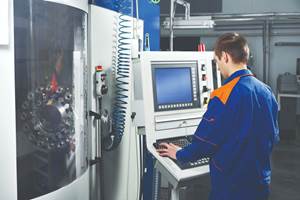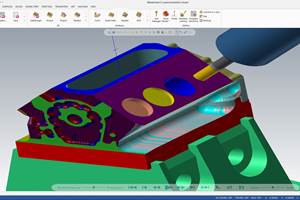CAM System Shaves Time Off Programming Four-Axis Turning Operation
Command Tooling has become a leading manufacturer of precision CNC toolholders. Its products, primarily end mill, collets and shell mill holders, are designed and manufactured to deliver the extreme gripping pressure that ensures precise tool centering and rigidity.
Command Tooling (Ramsey, Minnesota) has become a leading manufacturer of precision CNC toolholders. Its products, primarily end mill, collets and shell mill holders, are designed and manufactured to deliver the extreme gripping pressure that ensures precise tool centering and rigidity. As a result, tools last longer and cut more accurately.
Most of Command's products are machined on lathes. In many cases, quite a bit of metal must be removed from the stock piece to create the desired holder. The company has implemented four-axis lathes to speed this process. Four-axis lathes use two cutting tools simultaneously, inherently doubling the productivity of the machine. Programming the four-axis turning process was difficult at first, because the company's CAM system did not support four-axis machining. Command's programmers got around this by using the system to generate two separate two-axis programs, one for each of the cutting tools. Then they manually edited the M codes to combine the two programs into a single program that controlled the four-axis operation. This process was time consuming, as well as prone to error, because it was easy to make a typo while editing.
These drawbacks led Brad Hughes, Command Tooling's lead programmer, to evaluate a number of different CAM systems. His main criterion was support for four-axis turning, since that would reduce the time and errors that resulted from manually combining separate two-axis programs to get four-axis operations. In addition, he was looking for a CAM system that would permit access to the post file. Command's programmers were already skilled at manipulating post files as a simple way to adapt a program to a new machine or to allow a program to support a new indexer.
Mr. Hughes found only two programs that supported four-axis machining, and only one, ESPRIT from DP Technology, Camarillo, California, that provided the ability to manipulate the post file. This CAM system also featured knowledge-based machining, which allows it to capture information from a company's programs and original designs and helps build a database of knowledge to augment its own set of rules. "Adding knowledge to our programs would save time because it wouldn't be necessary to determine things like which tool is needed for a particular operation each time we program a part," says Mr. Hughes. "This capability was also appealing because it would give us more consistent programs. Each time a programmer worked on that particular part, the software would ensure that the preferred tool was used."
One additional factor that sold him on this software was its programming language, a comprehensive language with logic, loops and variables that is similar to C, a program that was already familiar to Command's programmers. "The macro language was important because our standard product line consists of families of parts," Mr. Hughes explains. "Writing macros would allow us to generate variations of a basic tool path in response to the user's input of different part dimensions."
Since most parts get drilled, bored and tapped, the operator is able to select these options from the software's motion page. When the programmer selects "drill," for instance, the software displays the drilling operation page, which is where the programmer identifies the appropriate drilling tool. However, as programmers have been adding knowledge to the software, more of these choices are already made. "I have the software set up so that each part has its own tool list with the correct speeds and feeds already specified," says Lyle Isaacson, programmer. At this point, the programmer signals the software to generate the tool path. From the time the CAD file is loaded into ESPRIT to when programming is complete takes 5 to 30 minutes. Command Tooling repeats this process between 400 to 800 times per month, since much of the company's business involves custom products. Thus, reducing programming time by 50 minutes per program yields an overall time savings of about 250 hours per month.
To save even more time, Command Tooling has also written ESPRIT macros that automate the programming of certain standard products. For example, one macro generates a CNC program for a collet holder in only 1 to 2 minutes. When a programmer receives a request for a collet holder program, he simply loads the macro and answers seven questions about the part. The software then displays the geometry of the part in its modeling module. Finally, it sets up the sequence for the roughing and finishing of the outer diameter, as well the commands for the required drilling and boring. Programs for some standard parts now take less time through the use of a macro, which automates many of the programming tasks. "By entering new values into the macro, we can make changes to one ESPRIT program and produce CNC programs for an entire product family," says Mr. Hughes.
The purchase of CAM software that supports four-axis machining has significantly reduced programming time at Command. Each program took at least an hour to produce the old way. Simply having software that can generate code for multiple cutting tools operating simultaneously is a big improvement over modifying a two-axis G-code file. This improved software capability has reduced programming time, and the development of macros that automate tool path generation is shrinking it even further. With up to 800 tool paths being programmed each month, this reflects significant time savings.
Related Content
Understanding CNC Machine Accuracy and Repeatability
Properly evaluating machine tool capability requires understanding how the both user and the builder can influence precision.
Read MoreTips for Designing CNC Programs That Help Operators
The way a G-code program is formatted directly affects the productivity of the CNC people who use them. Design CNC programs that make CNC setup people and operators’ jobs easier.
Read MoreHow to Grow the Business with Real-Time Job Status Data
ERP systems that focus on making data more accessible can improve communication within a shop, reducing wasteful errors and improving capacity.
Read MoreCAD/CAM System Requirements: An Overview
CAD/CAM programs are among the most demanding kinds of computer software. Smooth operation requires careful consideration of computer specifications.
Read MoreRead Next
Obscure CNC Features That Can Help (or Hurt) You
You cannot begin to take advantage of an available feature if you do not know it exists. Conversely, you will not know how to avoid CNC features that may be detrimental to your process.
Read More3 Mistakes That Cause CNC Programs to Fail
Despite enhancements to manufacturing technology, there are still issues today that can cause programs to fail. These failures can cause lost time, scrapped parts, damaged machines and even injured operators.
Read MoreThe Cut Scene: The Finer Details of Large-Format Machining
Small details and features can have an outsized impact on large parts, such as Barbco’s collapsible utility drill head.
Read More













.png;maxWidth=300;quality=90)











